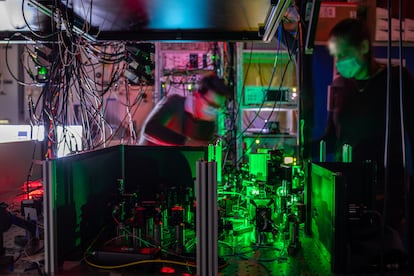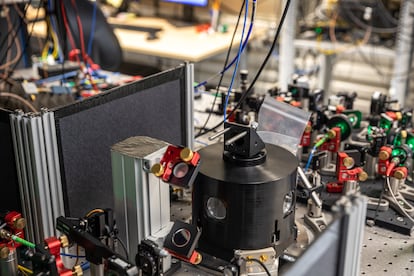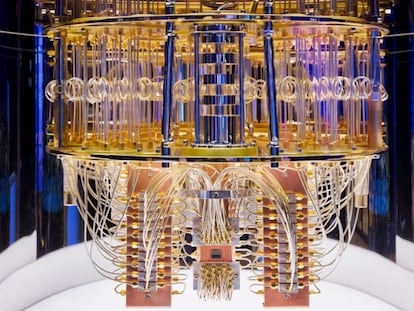Teleportation breakthrough paves the way for quantum internet
A Dutch team has succeeded in exchanging qubits between distant nodes with no direct connection between sender and receiver

Quantum computing is advancing in both tiny and giant steps. Tiny, because what is achieved involves unique breakthroughs of limitations; giant, because each stride opens up a world of infinite possibilities.
One such step has been taken by a research team led by Ronald Hanson, a physicist at the QuTech laboratory at Delft University in the Netherlands, which has succeeded in teleporting quantum information via a rudimentary network with no direct connection between sender and receiver.
This quantum leap, published Wednesday in Nature, means we are one step closer to a quantum internet which would then lead to an entirely new kind of computer that could carry out tasks that would take supercomputers thousands of years in a matter of minutes, paving the way for huge progress in the realms of medicine and artificial intelligence.
Basic teleportation had already been achieved – Hanson’s team and others have already demonstrated it – but only between two points, or adjacent nodes, named Alice and Bob. Now, Hanson’s team have managed to link this pair at a distance with a third, Charlie. The trio form the first network that, although rudimentary, allows us to contemplate a quantum internet, with infinite possibilities for computation and for observing a hitherto unknown world.
Explaining the relevance of this primordial quantum network, Hanson says: “Regarding quantum communication, our work shows how teleportation can be used in a real network environment, with nodes that have no direct connection. In a future quantum internet, such teleportation will be the main way to transfer quantum information over large distances. Our network can be viewed as a modular quantum computer [where the nodes are the modules]; our work shows that nodes can exchange quantum information, even if they are not on a single chip.”
To understand the progress made by Hanson’s team, we must look back at the previous achievements in this field. The first of these was the demonstration that teleportation is possible in the quantum world. The late Israeli physicist, Asher Peres, who died in 2005, anticipated the phenomenon in the Physical Review Letters in 1993. When a reporter asked him if quantum teleportation could transport the soul as well as the body, the physicist replied: “Not the body, just the soul.”
This anecdote is significant for understanding quantum teleportation, where it is not matter that is transported through a medium but the information that confers its properties. As Hanson explains: “The key feature of quantum teleportation is that the quantum information itself is actually teleported: it does not travel through space or fiber. The entangled pair of qubits, which is the resource for executing the teleportation – the ‘teleporter’ – is prepared by using a signal through fiber.” Another term for this phenomenon was coined by Albert Einstein: “Spooky action at a distance.” He himself deemed it impossible.

Thus, when one particle is previously entangled with another, both cease to be individual particles with defined states of their own and become a system with a single wave function. And any measurement that occurs in Alice is replicated instantaneously in Bob. This is how Hanson explains it: “Measuring one of them immediately causes the other to also choose a state; in a sense, measuring one also measures the other. This is very different from qubit manipulation: if we rotate Alice, nothing happens to Bob. Therefore, the spooky action at a distance [that Einstein spoke of] only refers to the instantaneous correlation in the measurement results. If other things besides measurement were also transferred instantaneously, it would actually be possible to send messages faster than the speed of light.”
Teleportation has been under experiment for a quarter of a century, starting with photons and moving on to atoms and more complex systems. Five years ago, Jian-Wei Pan, the leading researcher in this field who works at China’s University of Science and Technology, succeeded along with his team in teleporting photons from Earth to the artificial satellite Micius, orbiting at an altitude of 1,400 kilometers.
Jian-Wei Pan himself explained to EL PAÍS how these achievements, which are fundamental to quantum computing, have to overcome a “formidable challenge” in the shape of the presence of noise and imperfections. “We need to use quantum error correction and fault-tolerant operations to overcome the noise and scale up the system,” he said earlier this year.
If the presence of noise and imperfections can cause a quantum operation to fail on a singular computer in laboratory conditions, the problem is multiplied in a networked operation. And this has been Hanson and his team’s main achievement: efficient quantum teleportation between non-adjacent nodes in a network.

The Dutch researcher explains: “Noise and imperfections are a challenge for quantum information processing. In a quantum network, sending information across nodes could be done through the intermediate fibers, but that would make the quantum information subject to noise and fiber channel losses. In contrast, teleportation allows quantum information to be sent between distant nodes without interference from these sources of noise. Teleportation requires entanglement as a resource. Bob helps create that entanglement between Alice and Charlie, who do not share a direct physical connection.”
The process comes on the heels of previous research where Hanson got a network to function between adjacent nodes. The challenge was to add a third node and create a state between the three that showed quantum correlations.
In the new experiment, Alice and Charlie lack direct connection to each other, but both are connected to Bob. Alice and Bob’s quantum systems prepare the process using an intertwined state between each other, one which Bob stores, freeing him up to create an entanglement with Charlie. “After preparing an entanglement between Alice and Charlie, the state to be teleported is created and then executed,” says Hanson. “What happens then is something that is only possible in the quantum world: as a result of the measurement, the information disappears from Charlie’s side and immediately appears on Alice’s side.”
“The necessary principles for quantum networks”
Juan José García Ripoll, research scientist at the Spanish National Research Council (CSIC) Institute of Fundamental Physics and co-founder of Inspiration-Q, says the work of Hanson and his team is very important: “This is a very sophisticated experiment that demonstrates all the principles necessary for the creation of quantum communication networks,” he says.
According to García Ripoll, “sending not only classical information [bits] but also quantum states [arbitrary qubit states] requires a mechanism to distribute an entangled state between two distant points and a quantum memory [memory qubit] to store the information to be transmitted while establishing this communication channel based on entanglement.”
Hanson’s experiment uses Nitrogen-Vacancy (NV) centers, “a type of diamond impurity that acts like a qubit and can be optically manipulated,” says García Ripoll. “Through the emission of photons, this qubit makes it possible to create long-distance entanglement.” An NV-center is a defect whereby a carbon atom in the diamond crystal lattice is replaced by a nitrogen atom (N) and a neighboring vacancy (V).
A single NV can detect a magnetic moment of a single molecule and has wide applications in quantum technology. According to García Ripoll, “the NV-center or color center can also talk to the magnetic moments of surrounding atoms and, in [Hanson’s] experiment, they use this to gain a quantum memory by passing the NV information to a nearby nuclear spin [in a carbon-13 isotope]. The information to be sent can be kept safe for a long time, freeing the NV to perform the task of establishing entanglement with another communication node.
“Apart from the quality of the experiment, the demonstration of a sophisticated quantum communication setup with three nodes and very elaborate communication algorithms, lays the groundwork for its extension to scalable entanglement distribution and quantum communication setups that are very promising,” García Ripoll adds.
Premature, but important
For Adán Cabello, a physicist at Seville University in southern Spain whose first measurement of a quantum sequence was recognized as one of the major advances in physics, it is still too soon to speak of a quantum internet, although the experiment is significant as a teleport to a distant node.
Cabello attempts to explain the achievement in simplified terms. “You have a quantum state in a city that could be Seville and you want to send it to another city, say Madrid,” he says. “You need there to be a state of entangled qubits between Seville and Madrid. That is standard teleportation protocol. The interesting thing about the experiment is that the entanglement can only be established at a certain distance. Let’s say, in the example of the cities, it is 500 kilometers. If you want to send qubits from Seville to San Sebastián, you have to overcome the distance limitation. That’s what Hanson has managed: it’s no longer Seville-Madrid, it’s Seville-San Sebastián. The distance has been doubled.”
“It’s a first review of what a network could be,” adds Cabello. “It’s no longer point-to-point; you can already start to involve more nodes. But to talk about the quantum internet is getting ahead of ourselves. Nevertheless, teleporting quantum information is very useful and will have many applications, no doubt about it.”
In the same vein, physicists Oliver Slattery and Yong-Su Kim highlight the breakthrough achieved by Hanson and his team as an important and “critical” step towards the creation of a secure, next-generation quantum internet. They also stress the importance of the innovations developed to achieve the process: the preparation, manipulation and reading of quantum states.
However, both physicists point out: “Further improvements in multiple system features will be needed to enable multiple rounds of teleportation and produce large-scale quantum networks.”
Tu suscripción se está usando en otro dispositivo
¿Quieres añadir otro usuario a tu suscripción?
Si continúas leyendo en este dispositivo, no se podrá leer en el otro.
FlechaTu suscripción se está usando en otro dispositivo y solo puedes acceder a EL PAÍS desde un dispositivo a la vez.
Si quieres compartir tu cuenta, cambia tu suscripción a la modalidad Premium, así podrás añadir otro usuario. Cada uno accederá con su propia cuenta de email, lo que os permitirá personalizar vuestra experiencia en EL PAÍS.
¿Tienes una suscripción de empresa? Accede aquí para contratar más cuentas.
En el caso de no saber quién está usando tu cuenta, te recomendamos cambiar tu contraseña aquí.
Si decides continuar compartiendo tu cuenta, este mensaje se mostrará en tu dispositivo y en el de la otra persona que está usando tu cuenta de forma indefinida, afectando a tu experiencia de lectura. Puedes consultar aquí los términos y condiciones de la suscripción digital.
More information
Archived In
Últimas noticias
From safe-haven investment to geostrategic weapon: Who owns the most gold and where are the bars kept?
Todd Green, head of the company that created ‘Candy Crush’: ‘Success for us is that players want to play for years’
Prices soar and Venezuela’s economy struggles under Trump’s pressure: ‘People are living day to day’
Magnets in their heads: How some animals guide themselves using the Earth’s magnetic field
Most viewed
- Why we lost the habit of sleeping in two segments and how that changed our sense of time
- Charles Dubouloz, mountaineering star, retires at 36 with a farewell tour inspired by Walter Bonatti
- Venezuela faces its most tense Christmas yet
- CBS in crisis after pulling a report on Trump’s deportations to El Salvador (which later leaked online)
- Bukele clan fumes over investigation exposing their new wealth











































